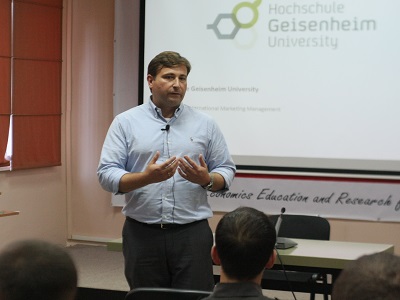On Wednesday, September 7, ISET hosted Dr. Jon Hanf, Head of the Wine Economics Program at Geisenheim University, Germany, who spoke about the prospects of Georgian wine in the highly competitive German market.
Dr. Hanf started his presentation by stating the obvious – the world market is saturated with wine as global supply steadily exceeds demand by more than 30 million hectoliters. Cutthroat competition results in average prices remaining extremely low, way below Georgian production costs. The German market – the largest and perhaps one of the most competitive wine markets in the world – is a good case in point. For example, very reasonable wines offered by major German discounters, such as Aldi and Lidl (controlling more than 35% of total wine sales in Germany) retail about 1,90-2 Euro per bottle. Premium wines average 8-9 Euro. For comparison, Georgian wines attempt to enter the German market at 12-15 Euro per bottle, way above competition.
The conclusion is that in order to sell, Georgian wines have to be branded as somehow unique. Georgia’s challenge in this regard is that very few Germans have any emotions for Georgia and Georgian products. The story that Georgia is “the cradle of wine” is potentially a good story. The problem is that other countries in the Caucasus are trying to tell the same story and can also credibly claim very old wine traditions. Perhaps, rather than telling competing stories, Georgian, Armenian and Azeri winemakers (not governments) could coordinate on a common message: the South Caucasus, as part of the Fertile Crescent, is indeed the cradle of wine civilization; all three countries still practice some of the ancient traditions (including fermentation in qvevri) and possess amazing varieties of soils, climate conditions and grapes that combine to produce unique wines. By pulling together financial resources and coordinating on a common branding and marketing campaign strategy, our wines could indeed have a chance in Europe. Alone we are bound to fail.











